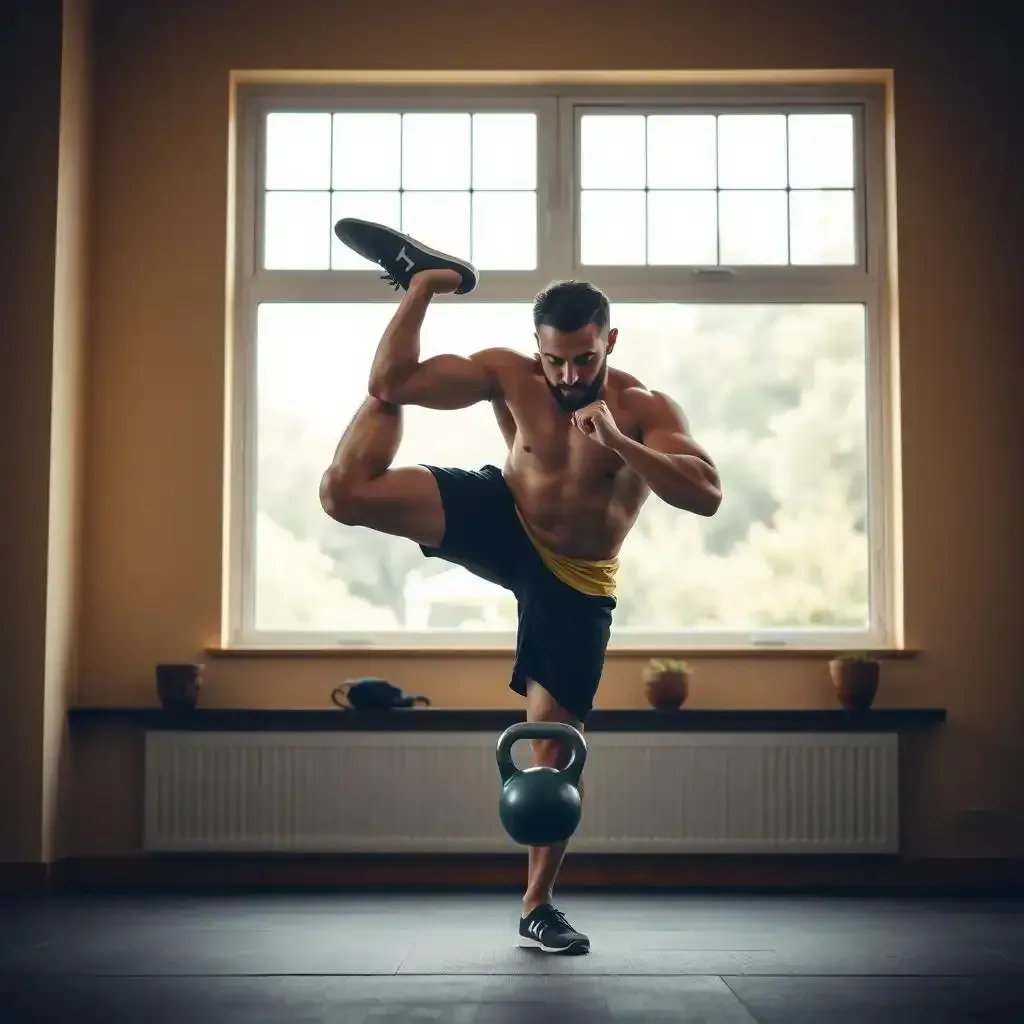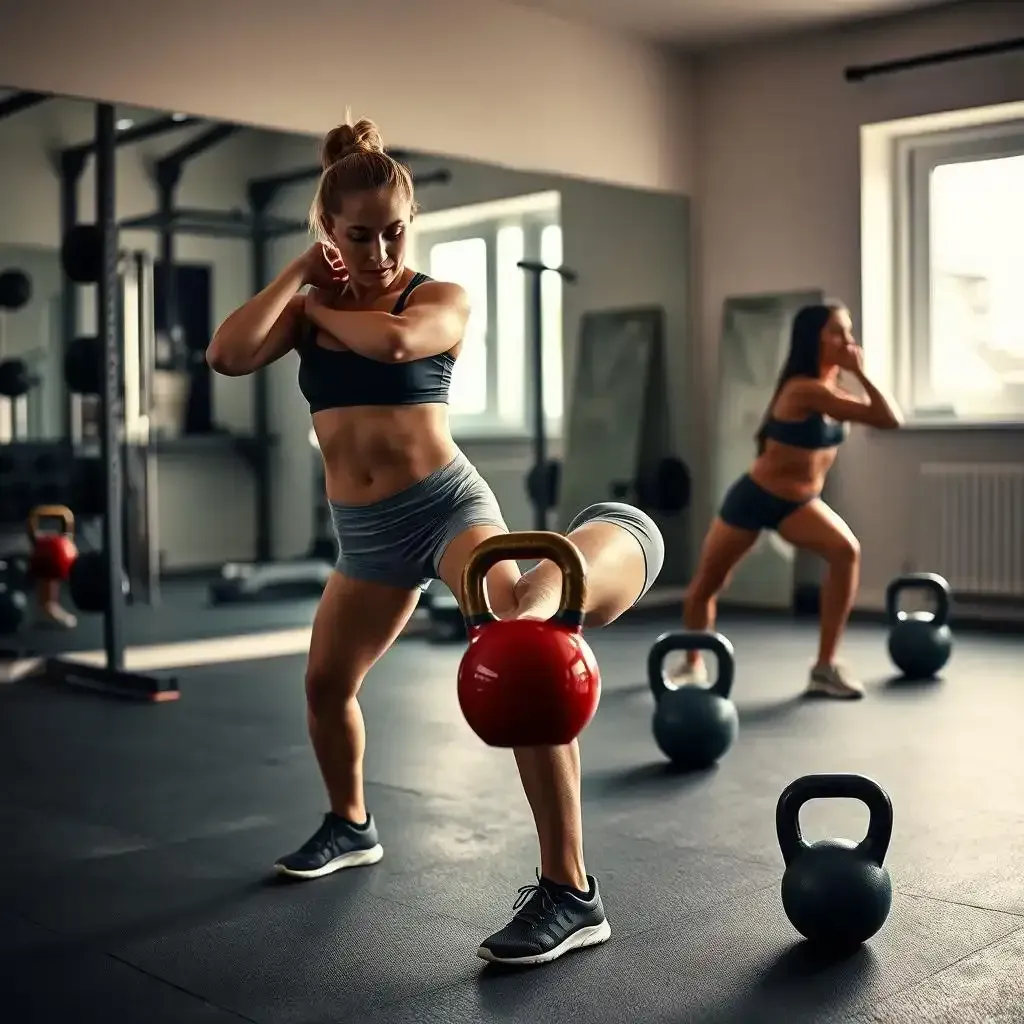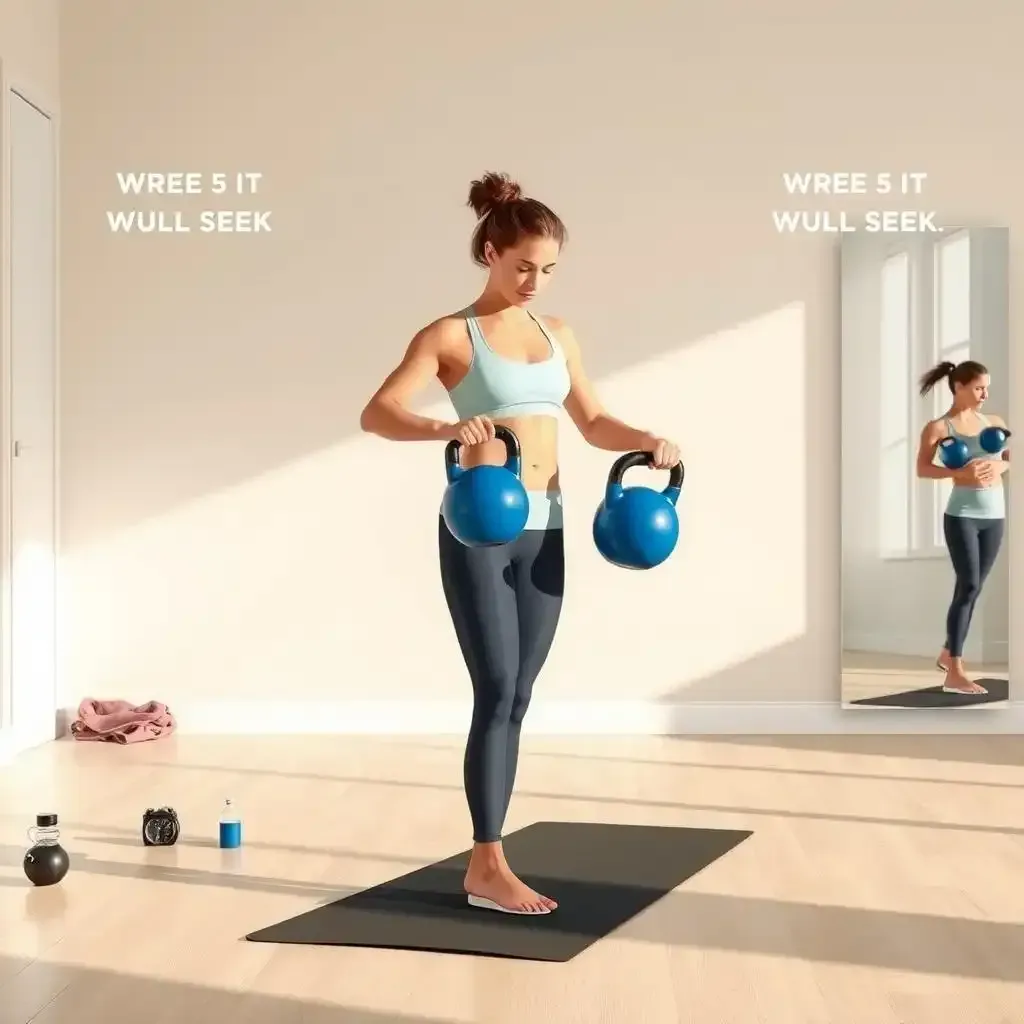Table of Contents
Maintaining balance is crucial for overall fitness and daily activities. Whether you're an athlete, a fitness enthusiast, or someone looking to stay agile and strong, kettlebell exercises can be a game-changer. Kettlebells are versatile tools that can help you improve your balance, core strength, and overall stability. In this article, we'll explore the best kettlebell exercises for balance and provide tips to help you master them. Whether you're a beginner or a seasoned pro, this guide will offer valuable insights and practical advice to enhance your fitness routine. So, let's explore into the world of kettlebell exercises for balance and uncover how they can transform your fitness progression. Stay with us on kettlebellworkout.homes, where we bring you the best in kettlebell workouts and fitness tips.
Kettlebell Exercises to Improve Balance and Stability

Kettlebell Exercises To Improve Balance And Stability
The Kettlebell's Unique Advantage
Hey there, fellow fitness enthusiast! Let's talk kettlebells and balance. I've been using kettlebells for years, and I'm constantly amazed at how they challenge your stability. Unlike dumbbells, which are typically held symmetrically, kettlebells’ off-center weight forces your body to work harder to stay upright. It's like a constant, gentle push-and-pull that strengthens your core and improves your balance. Think of it as a fun, challenging game of "don't fall over!" This constant engagement is what makes kettlebells so effective for building balance. You're not just lifting weight; you're training your body to adapt and react, much like learning to ride a bike. The more you practice, the more naturally balanced you become.
- Kettlebells challenge stability more than dumbbells.
- They improve balance through constant core engagement.
- Regular practice leads to improved natural balance.
Single-Leg Deadlifts: A Balance Building Block
One of my absolute favorite exercises for balance is the single-leg deadlift. It's deceptively simple, but incredibly effective. You stand on one leg, hinge at the hips, and lower a kettlebell towards the floor. It's like a graceful dance with gravity – except gravity is trying to make you fall! This movement strengthens your legs, glutes, and core, all crucial for balance. The key is to keep your back straight and your core tight. Imagine you’re a perfectly balanced tree, swaying gently but never falling. It’s all about controlled movement. Start with a lighter kettlebell and focus on form before increasing the weight. For more beginner kettlebell routines, check out our beginner routines section!
Exercise | Muscles Worked | Balance Benefit |
|---|---|---|
Single-Leg Deadlift | Legs, Glutes, Core | Improves hip and ankle stability |
Goblet Squats: Ability and Stability
Next up: goblet squats. Hold a kettlebell close to your chest, like you’re cradling a precious pumpkin (don't actually drop it!), and squat down. This exercise works your quads, glutes, and hamstrings, but it also demands incredible balance, especially when you're working on your form. It's a powerful move that will help you build strength and stability simultaneously. Again, focus on controlled movements, keeping your back straight and your core engaged. Remember, the goal is to feel strong and stable, not wobbly! If you’re new to kettlebells, our guide to kettlebell basics can help you get started.
"Balance isn't just about standing still; it's about moving with control and confidence." - Me (probably)
Why Kettlebells Are Perfect for Balance Training

Why Kettlebells Are Perfect For Balance Training
Okay, so you're thinking about kettlebells for balance? Smart move! I've seen firsthand how much they boost your stability. It's not just about the weight; it's about how that weight is distributed. Think of a dumbbell – the weight's evenly spread. A kettlebell? Nope, it’s all concentrated in that one spot. That forces your body to work extra hard to stay balanced. It’s like trying to stand on one leg while holding a bowling ball – challenging, right? But that challenge is exactly what builds up your core muscles and improves your sense of balance. It's like a secret superpower you access with every swing. And the best part? You get stronger and more balanced without even realizing it! You'll be walking across that wobbly bridge like a pro in no time. For more beginner-friendly moves, check out our kettlebell exercises for starters page.
- Uneven weight distribution challenges your stability.
- It strengthens your core muscles naturally.
- Improves balance without you even noticing.
I remember when I first started, I was a total klutz! I'd wobble around like a newborn giraffe trying to stand. But after a few weeks of consistent practice – even just 15 minutes a day – I noticed a huge difference. I felt steadier on my feet, more confident in my movements. That's the magic of kettlebells for balance – it's a gradual, rewarding process. It's not a quick fix, but it's a sustainable way to improve your balance for life. If you are a newbie, you can check out our kettlebell guide for newbies to get started easily.
Exercise Type | Muscle Focus | Balance Challenge |
|---|---|---|
Single-leg deadlifts | Legs, glutes, core | High – requires significant stability |
Goblet squats | Legs, glutes, core | Medium – good for building foundational balance |
Essential Kettlebell Exercises for Balance and Core Strength
Let’s investigate into some specific exercises. First up, the single-leg deadlift. I love this one! It’s like a ballet move – graceful, powerful, and totally tests your balance. You stand on one leg, hinge at your hips, and lower the kettlebell. The key is to keep your back straight and your core tight. Imagine a tree bending in the wind – strong, controlled, but not falling. It’s a fantastic way to improve your hip and ankle stability. Start with a light kettlebell and focus on perfect form before increasing the weight. For a more detailed guide, check out our .
Another amazing exercise is the goblet squat. Hold the kettlebell close to your chest – like you're holding a precious baby bird (don't actually hold a bird, though!). Then, squat down. It's a total body workout that challenges your balance while building serious leg and core strength. The key is controlled movement. Remember to keep your back straight and core engaged. It’s all about that feeling of stability and strength. If you're new to this, our will give you a solid foundation.
- Start with lighter weights and focus on form.
- Engage your core throughout each exercise.
- Control your movements for optimal results.
Don't underestimate the capability of simple exercises like Turkish get-ups. This exercise is a full-body movement that requires incredible balance and coordination. You start lying down and end standing, all while holding a kettlebell. It strengthens your whole body and improves your balance. Think of it as a full-body puzzle that strengthens your body and improves your balance. It’s a real test! It's challenging, but incredibly rewarding. And yes, it's okay to fall a few times – you'll learn from each stumble. For a more complete workout plan, see our kettlebell workout plan.
And finally, don’t forget the importance of a good warm-up and cool-down. Just like prepping for a race, a proper warm-up prepares your muscles and improves your balance. Some light cardio and dynamic stretches are perfect. After your workout, cool-down with static stretches to prevent muscle soreness. You’ll find more tips on our page about kettlebell warm-up exercises.
Exercise | Primary Muscles Worked | Balance Level |
|---|---|---|
Turkish Get-Ups | Full Body | High |
Kettlebell Swings | Hips, Glutes, Core | Medium |
Tips for Mastering Kettlebell Exercises for Balance
Mastering kettlebell exercises for balance takes time and practice. Don't get discouraged if you wobble a bit at first – it's totally normal. It's like learning to ride a bike – you’ll fall a few times before you feel confident. Consistency is key. Even short, regular sessions are better than infrequent, long ones. Listen to your body and don't push yourself too hard, especially when you're starting. Start slowly and gradually increase the weight and difficulty. Remember, safety first! Check out our kettlebell safety tips for more information.
Focus on proper form. It's more important than how much weight you lift. Poor form can lead to injuries, and it won't help you improve your balance. Watch videos, read instructions, and maybe even consider working with a trainer to ensure you're doing the exercises correctly. It's worth the investment in your body. And don't forget to have fun! Make it a game, challenge yourself, and celebrate your progress. You got this! Our kettlebell form guide can help you nail your technique.
- Start slow and gradually increase difficulty.
- Prioritize proper form over weight.
- Listen to your body and rest when needed.
Essential Kettlebell Exercises for Balance and Core Strength

Essential Kettlebell Exercises For Balance And Core Strength
So, you wanna build some serious balance? Kettlebells are your new best friend. Forget those boring old stability ball exercises – kettlebells add a whole new level of challenge. The weight isn't evenly distributed like in dumbbells; it's all concentrated in that bulbous bottom. This forces your body to work overtime to stay upright, building core strength like crazy. It's like trying to balance on a unicycle while juggling – tough, but the payoff is incredible. You’ll be amazed how much stronger and steadier you become.
Let's start with the single-leg deadlift. Think about this: you're standing on one leg, like a flamingo, holding a kettlebell. You hinge at your hips, lowering the kettlebell towards the ground. It's a fantastic exercise for your legs, glutes, and core – all essential for balance. The key is control; imagine you're a graceful dancer, not a wobbly toddler. Start light, focus on your form (check out our for help!), and gradually increase the weight as you get stronger. You'll be surprised how quickly you improve. It's totally doable, even for beginners, and a great step towards improving your stability and balance.
Exercise | Muscles Worked | Balance Challenge |
|---|---|---|
Single-leg Deadlift | Legs, Glutes, Core | High - needs serious stability |
Goblet Squat | Legs, Glutes, Core | Medium - builds a solid base |
Next up, the goblet squat. This is a classic, but kettlebells make it even more challenging. Hold the kettlebell close to your chest – imagine you're holding a very heavy, but precious, puppy. Squat down, keeping your back straight and core engaged. It’s a full-body workout that'll strengthen your legs and core while simultaneously improving your balance. Think of it as a strength pose for your legs and core. It’s all about controlled movement. Again, start light and focus on perfecting your form before adding more weight. For more beginner-friendly exercises, check out our page!
Now, let's talk about Turkish get-ups. This exercise is like a full-body puzzle, requiring balance, coordination, and a whole lot of strength. You start lying down and end standing, all while holding a kettlebell. It's challenging, but it builds amazing strength and improves your balance. Don’t be afraid to fall a few times – it's part of the learning process! If you’re a complete newbie, our is a great place to start. It’ll walk you through all the basics.
- Start with lighter weights and focus on form.
- Engage your core – it's the key to stability.
- Control your movements; slow and steady wins the race!
Remember, consistency is key. Even short, regular sessions are better than infrequent, long ones. And always listen to your body – don't push yourself too hard, especially when you’re starting out. It’s a marathon, not a sprint! For a complete workout plan, check out our .
Finally, don't forget to warm up before you start and cool down afterward. A good warm-up prepares your muscles and improves your balance, and a cool-down prevents muscle soreness. For some great warm-up and cool-down ideas, check out our page.
Exercise | Muscle Focus | Balance Difficulty |
|---|---|---|
Turkish Get-Ups | Full Body | High - it's a real challenge! |
Kettlebell Swings | Hips, Glutes, Core | Medium - good for building a base |
Tips for Mastering Kettlebell Exercises for Balance

Tips For Mastering Kettlebell Exercises For Balance
Start Slow and Steady, My Friend
Okay, let's talk strategy. Don't try to be a superhero on day one. Seriously, I've seen it happen – people trying to hoist a massive kettlebell and ending up on the floor looking like a deflated balloon. Start with lighter weights. It's like learning to ride a bike; you wouldn't jump on a BMX bike on your first try, would you? You’d start with training wheels, right? Same thing here. A lighter kettlebell lets you focus on your form. Perfect form is way more important than heavy weights. Think of it as building a strong foundation – you can't build a skyscraper on shaky ground. Once your form is solid, you can gradually increase the weight. It’s a progression, not a race!
- Begin with lighter weights to master your form.
- Focus on controlled movements; speed isn't the goal.
- Gradually increase the weight as you get stronger.
Remember those wobbly first steps? Yeah, we've all been there. And you know what? It's okay to wobble a little at first. It doesn't mean you're a failure. It simply means you're learning. Focus on your balance, engage your core, and keep practicing. Your balance will improve over time. It’s all about consistency and patience. Think about building muscle, it doesn’t happen overnight! For more tips on building a strong core, check out our core strengthening guide.
Week | Weight | Focus |
|---|---|---|
1 | 5-10 lbs | Form |
2 | 10-15 lbs | Stability |
3 | 15-20 lbs | Strength |
Listen to Your Body (Seriously!)
This is super important, especially when you are starting out. Your body is a wise old owl; it'll tell you when it needs a break. Don't ignore those little whispers. If you feel pain, stop. Pushing through pain is a recipe for injury. It's not about proving your toughness; it's about building a strong, healthy body. Rest is just as important as exercise. Think of your muscles like a sponge – they need time to absorb the workout and rebuild themselves. If you don't give them that time, they'll get grumpy and start protesting with pain. For more information on preventing injuries, check out our injury prevention tips.
And remember to breathe! Breathing is often overlooked, but it’s incredibly important for balance and stability. Deep, controlled breaths help you stay centered and focused. It’s like anchoring yourself to the earth. Focus on exhaling as you exert effort and inhaling during the recovery phase of your exercises. Try to make it a conscious part of your routine. Proper breathing can make all the difference in your balance exercises. For more information on how to improve your breathing technique, check out our breathing techniques guide.
- Rest when you need to; don't push through pain.
- Breathe deeply and consciously during exercises.
- Listen to your body and adjust your workout accordingly.
Final Thought
By incorporating kettlebell exercises into your fitness routine, you can significantly improve your balance, core strength, and overall stability. Whether you're a beginner or an advanced athlete, the exercises and tips we've discussed will help you achieve your fitness goals. Remember, consistency is key, and with regular practice, you'll see remarkable improvements. For more tips and workouts, stay connected with kettlebellworkout.homes. Start your trip today and watch your balance soar!